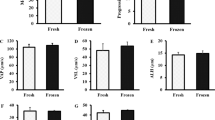Abstract
We investigated the application of cryopreserved pronuclear‐stage zygotes for the production of transgenic rats. Most of the pronuclear‐stage zygotes cryopreserved by conventional two‐step freezing or vitrification appeared morphologically normal, but the proportion of frozen zygotes that developed into fetuses following transfer (59.7–60.2%) was higher than that of vitrified zygotes (5.5–22.1%). When the frozen‐thawed zygotes were used for DNA microinjection, 97.5% survived after DNA microinjection and 25.1% of the transferred zygotes developed into fetuses. These proportions were comparable to those of the fresh control zygotes (97.0% and 30.0%, respectively). The integration efficiency of the exogenous DNA into fetuses was similar between the frozen group (3.3% per injected zygote) and the control group (3.5%). These results indicate that pronuclear‐stage rat zygotes can be successfully cryopreserved by conventional two‐step freezing for production of transgenic rats.
Similar content being viewed by others
References
AnzaiM, Nakagata N, Matsumoto K, Takahashi A, Takahashi Y and Miyata K (1994) Cryopreservation of in-vitro fertilized embryos from transgenic rat by ultra-rapid freezing. Exp Anim 43: 247–250.
Bernart W, Kamel M, Neulen J and Breckwoldt M (1994) Influence of the developmental stage and the equilibration time on the outcome of ultra-rapid cryopreservation of mouse embryos. Hum Reprod 9: 100–102.
Charreau B, Tesson L, Busacail J, Soulillou JP and Anegon I (1996) Analysis of human CDS9 tissue expression directed by the CMV-IE-1 promoter in the transgenic rats. Transgenic Res 5: 443–450.
Hammer RE, Maika SD, Richardson JA, Tang J and Taurog J (1990) Spontaneous inflammatory disease in transgenic rats expressing HLA-B27 and human _2m: an animal model of I-HLA-B27-associated human disorders. Cell 63: 1099–1112.
Heideman J (1991) Transgenic rats: a discussion. Bio/Technology 16: 325–332.
Hirabayashi M and Chaya N (1990) Low temperature storage of rat 2-cell embryos by vitrification. J Mamm Ova Res 7: 72–77.
Hirabayashi M, Takahashi R, Sekiguchi J and Ueda M (1997) Viability of transgenic rat embryos after freezing and thawing. Exp Anim 46: 111–115.
Hochi S, Ninomiya T, Honma M and Yuki A (1990) Successful production of transgenic rats. Anim Biotechnol 1: 175–184.
Hochi S, Ninomiya T, Waga-Honma M, Sagara J and Yuki A (1992)Secretion of bovine _-lactalbumin into the milk of transgenic rats. Mol Reprod Dev 33: 160–164.
Kono T, Suzuki O and Tsunoda Y (1988) Cryopreservation of rat blastocysts by vitrification. Cryobiology 25170–173.
Leibo SP, Demayo FJ and O'malley B (1991) Production of transgenic mice from cryopreserved fertilized ova. Mol Reprod Dev 30: 313–319.
Martino A, Songasen N and Leibo SP (1996) Development into blastocysts of bovine oocvtes cryopreserved by ultra-rapid cooling. Biol Reprod 54: 1059–1069
Mukumoto S, Mori K and Ishikawa H (1995) Efficient induction of superovulation in adult rats by PMSG and hGH. Exp Anim 44: 111–118.
Nakao K, Nakagata N and Katsuki M (1997) Simple and efficient vitrification procedure for cryopreservation of mouse embryos. Exp Anim 46: 321–324.
Ninomiya T, Hirabayashi M, Sagara J and Yuki A (1994) Function of milk protein gene 50 flanking regions on human growth hormone gene. Mol Reprod Dev 37: 276–283.
Ogawa S, Satoh K, Hamada M and Hashimoto H (1971) In-vitro culture of rabbit ova from the single cell to the blastocyst stage. Nature 233: 422–424.
Paul M, Wagner J, Hoffmann S, Urata H and Ganten D (1994) Transgenic rats: new experimental models for the study of candidate genes in hypertension research. Annu Rev Physiol 56: 811–829.
Tada N, Sato M, Kasai K and Ogawa S (1995a) Production of transgenic mice by microinjection of DNA into vitrified pronuclearstage eggs. Transgenic Res 4: 208–211.
Tada N, Sato M, Mizorogi T, Kasai K and Ogawa S (1995b) Cryopreservation of hairless mutant rat (bald) and normal Wistar rat embryos by vitrification. Lab Anim Sci 45: 323–325.
Utsumi K, Hochi S and Iritani A (1992) Cryoprotective effect of polyols on rat embryos during two-step freezing. Cryobiology 29: 332–341.
Vaijta G, Holm P, Kuwayama M, Booth PJ, Jacobsen H, Greve T and Callensen H (1998) Open pulled straw (OPS) vitrification: A new way to reduce cryoinjuries of bovine ova and embryos. Mol Reprod Dev 51: 53–58
Whittingham DG (1974) Embryo banks in the future of developmental genetics. Genetics 78: 395–402.
Whittingham DG (1975) Survival of rat embryos after freezing and thawing. J Reprod Fertil 43: 575–578.
Author information
Authors and Affiliations
Rights and permissions
About this article
Cite this article
Takahashi, R., Hirabayashi, M. & Ueda, M. Production of transgenic rats using cryopreserved pronuclear‐stage zygotes. Transgenic Res 8, 397–400 (1999). https://doi.org/10.1023/A:1008910629235
Issue Date:
DOI: https://doi.org/10.1023/A:1008910629235




